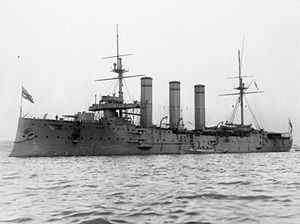HMS Bedford (1901)
 Bedford at anchor | |
| Career (United Kingdom) | |
|---|---|
| Name: | HMS Bedford |
| Namesake: | Bedfordshire |
| Builder: | Fairfield Shipbuilding & Engineering, Govan |
| Laid down: | 19 February 1900 |
| Launched: | 31 August 1901 |
| Christened: | Hon. Mrs. James C. Burns |
| Completed: | 11 November 1903 |
| Fate: | Wrecked, 21 August 1910 |
| General characteristics | |
| Class and type: | Monmouth-class armoured cruiser |
| Displacement: | 9,800 long tons (10,000 t) (normal) |
| Length: | 463 ft 6 in (141.3 m) (o/a) |
| Beam: | 66 ft (20.1 m) |
| Draught: | 25 ft (7.6 m) |
| Installed power: | 22,000 ihp (16,000 kW) 31 water-tube boilers |
| Propulsion: | 2 × shafts 2 × 4-cylinder triple-expansion steam engines |
| Speed: | 23 knots (43 km/h; 26 mph) |
| Complement: | 678 |
| Armament: |
|
| Armour: | |
HMS Bedford was one of 10 Monmouth-class armoured cruisers built for the Royal Navy in the first decade of the 20th century. She was assigned to the 1st Cruiser Squadron of the Channel Fleet upon completion in 1903 before she was briefly reduced to reserve in 1906. Bedford was recommissioned the following year for service with China Station and ran aground in 1910. Her wreck was sold for scrap later that year.
Design and description
Bedford was designed to displace 9,800 long tons (10,000 t). The ship had an overall length of 463 feet 6 inches (141.3 m), a beam of 66 feet (20.1 m) and a deep draught of 25 feet (7.6 m). She was powered by two 4-cylinder triple-expansion steam engines, each driving one shaft, which produced a total of 22,000 indicated horsepower (16,000 kW) and gave a maximum speed of 23 knots (43 km/h; 26 mph). The engines were powered by 31 Belleville boilers. [1] Bedford was fitted for partial oil burning as an experiment.[2] She carried a maximum of 1,600 long tons (1,600 t) of coal and her complement consisted of 678 officers and enlisted men.[3]
Her main armament consisted of fourteen breech-loading (BL) 6-inch Mk VII guns.[4] Four of these guns were mounted in two twin-gun turrets, one each fore and aft of the superstructure and the others positioned in casemates amidships. Six of these were mounted on the main deck and were only usable in calm weather.[5] They had a maximum range of approximately 12,200 yards (11,200 m) with their 100-pound (45 kg) shells.[6] Ten quick-firing (QF) 12-pounder 12 cwt guns were fitted for defence against torpedo boats.[3] Bedford also carried three 3-pounder Hotchkiss guns and two submerged 18-inch torpedo tubes.[1]
The ship's waterline armour belt had a maximum thickness of four inches (102 mm) and was closed off by five-inch (127 mm) transverse bulkheads. The armour of the gun turrets and their barbettes was four inches thick while the casemate armour was five inches thick. The protective deck armour ranged in thickness from .75–2 inches (19–51 mm) and the conning tower was protected by ten inches (254 mm) of armour.[1]
Construction and service
Bedford, named after the English county,[7] was laid down on 19 February 1900 by Fairfield Shipbuilding & Engineering at their Govan shipyard. She was launched on 31 August 1901, when she was christened by Charlotte Mary Emily Burns, wife of the Hon. James Cleland Burns, of the Cunard Line shipping family.[8] In May 1902 she was navigated to Devonport for completion and trials.[9] She was completed on 11 November 1903 and initially assigned to the 1st Cruiser Squadron of the Channel Fleet. Bedford was briefly placed in reserve at the Nore in 1906[10] before being recommissioned in February 1907 for service on the China Station. She was wrecked on 21 August 1910 at Quelpart Island in the East China Sea with 18 men killed. The wreck was subsequently sold for breaking up on 10 October 1910.[11]
Notes
- ↑ "Cwt" is the abbreviation for hundredweight, 12 cwt referring to the weight of the gun.
Footnotes
- ↑ 1.0 1.1 1.2 Chesneau & Kolesnik, p. 70
- ↑ McBride, p. 23
- ↑ 3.0 3.1 Friedman 2012, p. 336
- ↑ Friedman 2011, p. 81
- ↑ Friedman 2012, pp. 251–52, 260–61
- ↑ Friedman 2011, pp. 80–81
- ↑ Silverstone, p. 216
- ↑ "Naval & Military Intelligence" The Times (London). Monday, 2 September 1901. (36549), p. 5.
- ↑ "Naval & Military intelligence" The Times (London). Friday, 9 May 1902. (36763), p. 10.
- ↑ Friedman 2012, pp. 251, 342
- ↑ Gardiner & Gray, p. 12
Bibliography
- Chesneau, Roger & Kolesnik, Eugene M., eds. (1979). Conway's All the World's Fighting Ships 1860–1905. Greenwich: Conway Maritime Press. ISBN 0-8317-0302-4.
- Friedman, Norman (2012). British Cruisers of the Victorian Era. Barnsley, South Yorkshire, UK: Seaforth. ISBN 978-1-59114-068-9.
- Friedman, Norman (2011). Naval Weapons of World War One. Barnsley, South Yorkshire, UK: Seaforth. ISBN 978-1-84832-100-7.
- Gardiner, Robert & Gray, Randal, eds. (1984). Conway's All the World's Fighting Ships: 1906–1921. Annapolis, Maryland: Naval Institute Press. ISBN 0-85177-245-5.
- McBride, Keith (1988). "The First County Class Cruisers of the Royal Navy, Part I: The Monmouths". Warship (London: Conway Maritime Press) 47 (April): 19–26. ISSN 0142-6222.
- Silverstone, Paul H. (1984). Directory of the World's Capital Ships. New York: Hippocrene Books. ISBN 0-88254-979-0.
| ||||||||||